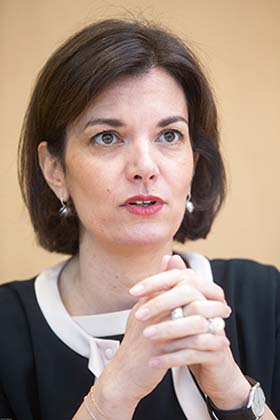Julie Becker of the Luxembourg Stock Exchange talks about the role the exchange provider plays in bringing together various players in sustainable finance, including through a ‘window’ for socially responsible investment (SRI) funds.
Two years ago, the Luxembourg Stock Exchange (LuxSE) launched an exchange dedicated to green, social and sustainability bonds and bond issuance on it has reached over $100 billion.
Known as the Luxembourg Green Exchange (LGX), the exchange has recently created a ‘window’ for the display of SRI funds. NN Investment Partners is among the asset managers with products fulfilling necessary criteria, including transparency, to be displayed on LGX.
Julie Becker, an executive committee member of LuxSE (pictured below), explains that the origins of the LGX stem from 2007, when LuxSE listed the first ever green bond – the European Investment Bank’s Climate Awareness Bond.
Since then, the European and international regulatory landscape has evolved and established standards for the green bond industry. These include the Green Bond Principles issued by the International Capital Markets Association. Others include the Social Bond Principles and Sustainability Bond Guidelines, the Climate Bonds Taxonomy, or the People’s Bank of China Green Bond Endorsed Project Catalogue.
“Our aim is to translate these industry best practices into mandatory requirements,” Becker says, and adds that the bonds listed on LGX also contribute to the achievement of the UN Sustainable Development Goals (SDGs).
“When we started, the value of the bonds displayed was around $43bn but it has grown to over 200 bonds with a value of over $100bn. We have a wide range of issuers including sovereigns, supra-nationals, agencies and development banks, as well as financial institutions and corporates,” says Becker.
“We initially focused on green bonds, adding social and sustainability bonds shortly afterwards and have recently launched an SRI window dedicated to ESG, green and social funds. The bar for issuers is set high. There are strict issuance criteria, such as a recognised fund label, external reviews and post-issuance reporting. Our goal is to be the world’s leading platform for the most comprehensive information about sustainable finance products across asset classes, geographies, investment strategies, products and services.”
SRI fund listings
The responsible investment window was launched in May. The intention is to provide a space for investors and fund selectors to identify funds carrying robust environmental, social and governance (ESG) characteristics.
Currently 24 share classes are displayed from managers including East Capital, Generali, Humanis Gestion d’Actifs, Luxembourg Microfinance and Development Fund, NN Investment Partners, Nord Est Asset Management, Selectra and Sparinvest.
 “As with bonds, the funds have to meet strict criteria and obtain labels that guarantee a certain level of transparency,” says Becker. They include labels from Luxembourg-based LuxFLAG, which offers ESG, climate finance, environment and microfinance labels. Other labels include FNG’s label for sustainable mutual funds, the Nordic Swan Ecolabel for funds, and the French government’s SRI and TEEC (the energy and ecological transition for climate) labels.
“As with bonds, the funds have to meet strict criteria and obtain labels that guarantee a certain level of transparency,” says Becker. They include labels from Luxembourg-based LuxFLAG, which offers ESG, climate finance, environment and microfinance labels. Other labels include FNG’s label for sustainable mutual funds, the Nordic Swan Ecolabel for funds, and the French government’s SRI and TEEC (the energy and ecological transition for climate) labels.
“This ensures that investors know that their investments are really sustainable and green, while fund managers get more visibility and access to a wider distribution channel for their funds. They are thus able to diversify their investor base,” says Becker.
One of the main problems in the sustainable investment products market is a lack of definition and harmonisation in the market, says Becker.
“There are no standard definitions or regulated frameworks, which makes it difficult for investors to make comparisons between products or to determine whether the project is in fact sustainable. We provide greater disclosure which not only helps investors make better-informed decisions, but also enables fund managers to make their products more visible to a wider and more diversified investor base.”
There is little doubt that ESG is growing as an investment theme, but green finance is still a niche. What must change to put it in the mainstream?
“I think what we need most is a change in mind-set and behaviour. We need to understand the urgency to move towards a more sustainable economy and channel more capital towards sustainable investment projects. On top of that, we need a more robust framework and comparable data sets for sustainable investing. I think regulators can play a role in helping to develop common standards, taxonomy and terms of reference. We need to talk the same language and have the same concept of sustainability.
“We are in a transition phase, but I am optimistic about this – there is a growing demand from investors for SRI funds, especially from millennials who want SRI products that better reflect their values. The pressure for change will ultimately come from the investors.”
A high level of input
Becker is a former member of the European Union High Level Expert Group on sustainable finance and was involved in discussions that led to the EU Action Plan on Financing Sustainable Growth. This is another development that could see green finance enter the mainstream.
The European Commission launched the Action Plan on 8 March 2018, to provide the market with greater clarity, understanding and integrity surrounding sustainable investing. It was a response to market needs, Becker says, and it recommended the development of a taxonomy – meaning an EU classification system – for sustainable economic activities.
There was also a proposal to improve disclosure so that analysts could produce more reliable reports to investors. Also, institutional investors, asset managers, insurance distributors and investment advisors who have sustainable funds would have to take greater responsibility for ensuring that the green finance market functions properly.
Becker explains: “They would need to disclose the procedures they have in place to integrate ESG risks into their investment and advisory process, the extent to which ESG risks are expected to have an impact on the returns of the product or service provided, and how they comply with those sustainability objectives in their investment decisions.”
The Action Plan still has to be fully implemented. Becker is certain that it would provide a breakthrough for sustainable finance.
She says: “I think the Action Plan on Financing Sustainable Growth goes a long way in helping make sustainability mainstream and I hope it will be implemented as quickly as possible.”
Becker insists that “sustainable finance should be on everyone’s mind and all market participants should act on it, without waiting for the regulatory framework to be put in place.”
©2018 funds europe





